
Lion dance is a passion that is often passed down through families. The Chinese Masonic Society Lion Dance Team is the oldest team in Melbourne and one of the earliest to embrace women performers. Their roots trace back to the gold rush, though they moved over to the city early on.
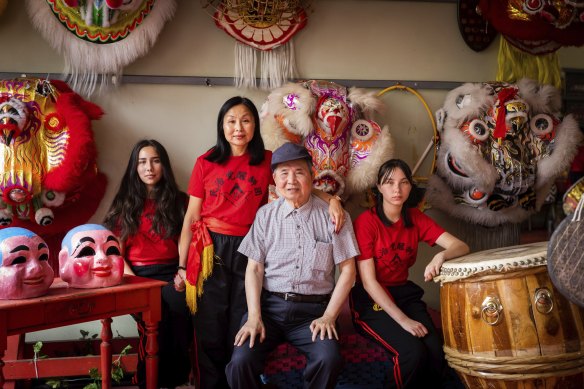
Julie Chen with her father You Ching Chen, 87, her daughters Maya, 16 and Kayla, 14.Credit:Paul Jeffers
Having performed since the 1940s, many current members have family who were involved in earlier years, including Julie Chen who was one of the first female lion dancers in Australia whose daughters Maya and Kayla are now also learning the dance.
Amber Lee is a fourth generation lion dancer with CMS, with the love of the art-form being passed down through her father’s side of the family. “It started with my great-grandfather,” she explains, then went on to her grand uncle, who then brought her father in during the 1980s. “As a kid I always wanted to follow wherever Dad was going,” she says.
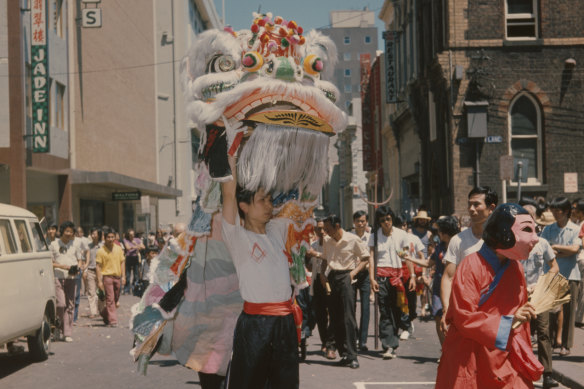
Julie Chen’s father, You Ching Chen, performing with the Chinese Masonic Society Lion Team in 1974.
In the early 2000s she was tentatively interested in getting involved, “but I guess at the time, I was a little bit too shy because there weren’t too many girls around – and the firecrackers seemed a little bit scary too” she adds with a laugh. In 2018, when she started at university, she also decided to fully embrace lion dance and now regularly features in performances as well as helping out as an instructor.
How to train your lion
There are a lot of different roles in a lion dance performance. There are the musicians, the two performers in the lion, and the big-headed buddha which is often a role given to a returning member who may have long since retired. “We even have people in their 90s still performing,” says Zhen Lim, who following in his father’s footsteps, has been involved with the Chinese Masonic Society for the last six years.
From getting started to performing in front of an audience is rarely a quick process. How long things takes depends on the individual. Lim started at age 30 but came from a martial arts background. Generally, he explains “You’re looking at one year to get all the foundations right, and then the next one to five years to be actually proficient in the art.”
Clinton Miller, lion team leader at the Bendigo Chinese Association also came from a martial arts background, with a focus on judo. For him, it took six months from getting started to performing, but he explains that is unusually fast.
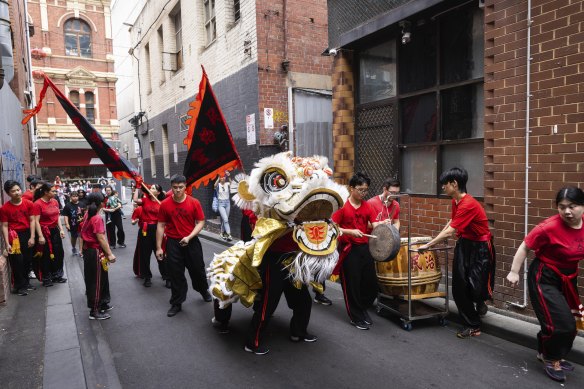
The Chinese Masonic Society Lion Dance Team perform a practice parade in Chinatown, January 2023.Credit:Paul Jeffers
All three clubs emphasise the importance of regular training, ranging from once to three times a week depending on the goals of both the individual and the team.
“It’s like any other sport – the amount that you put into it is what you get out of it,” says Lee. She trained intensively for two years, which is around the average for most performers. But, she emphasises :“it’s not two years and you’re straight into the lion or you’re straight into these fancy VIP performances. It’s quite a gradual process.”
In terms of who goes where, the idea behind training is that performers are flexible, though people do sometimes specialise. Miller often is the back of the lion. “The tails have to do a lot of the lifting, so it’s typically a stronger person,” he explains. For Lee, “generally, because I am lighter to lift, I’m usually the lion head – and more recently, I’ve been doing a bit on the drums, which is pretty fun.”
A significant part of the training involves learning key stances which form the foundation of the lion dance choreography. “If you don’t concentrate on your stances or get them really strong, nothing will work the way it should,” says Miller. “You’ll wear out, your upper body will tire out a lot easier than your legs and so forth.”
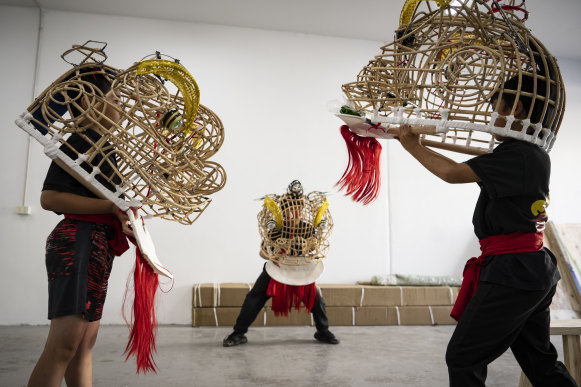
Members of the Lion Dance Kids group train at their Kingsgrove studio in January 2023.Credit:Wolter Peeters
Leung agrees that drilling your stances until they are second nature is essential. “The whole idea is to make the costume look like a lion. So if your legs are standing straight, then you’re looking more like a horse.”
At the same time, Lim highlights the importance of being across every aspect of the performance, including the music. Trainees start with the cymbals, then move on to the gong, with the drums coming later. “You can’t do music without knowing the lion, you can’t know the lion without knowing the music.”
Times are changing
Across the different generations, and even over just recent years, lion dancers have witnessed changes happening within the art-form. “It’s continually evolving,” says Lim. “We have people here five, 10 years, and they’re still working on their skills and the stamina and developing the art.
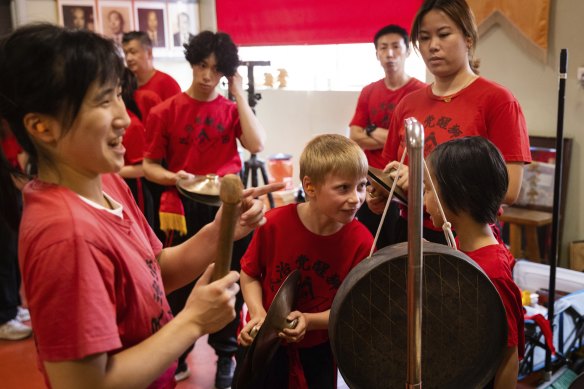
Amber Lee (left) training with other members of the Chinese Masonic Society Lion Dance Team. Credit:Paul Jeffers
“A beautiful thing about lion dancing is that the style has evolved a lot since my great grand uncle brought his style from the ’60s and ‘70s,” says Lee. Her father, who performed in the ’80s has seen her in action and “he’s definitely observed a few tweaks in the moves that I do.”
All of the performers emphasise the importance of bringing in the next generation. The Bendigo Chinese Association team has opened up training to younger people, with a specific hour each week dedicated to juniors.
Yau Kung Mun, in addition to training adults also has lion dance kids – where every participant from the lion, to the monk, to those playing instruments is a child between the ages of 5 and 12, with about 50 children altogether signed up for training.
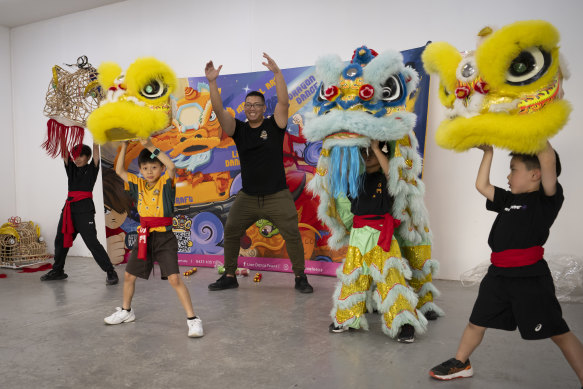
Johnny Leung leads a training session for Lion Dance Kids. Credit:Wolter Peeters
CMS also has a youth team made up of teenagers between 14 and 18 who have been learning since they were 10. “There’s a big focus for us on developing the new generation,” says Lim. “A lot of kids come to us very shy and reserved and we try and encourage them to come out of their shell gradually by giving them responsibilities and giving them performances.”
Loading
All of the lion dancers this masthead spoke to underscore their love of the dance itself and the community that forms around it as well as the connection it brings to Chinese culture.
“Lion dancing is unique. It’s a full age spread, and everyone’s involved in some way or another,” says Lim.
“The vast majority of us are ABCs, or Australian-born Chinese,” says Lee. “Being able to bond over that, coming together as a team and letting the culture live on to future generations, I think is what I find very important about lion dancing.”
A cultural guide to going out and loving your city. Sign up to our Culture Fix newsletter here.









 Add Category
Add Category